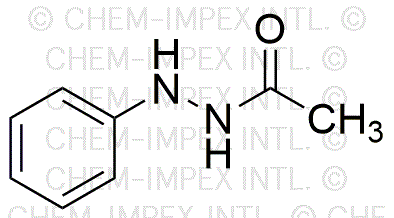1-Acetyl-2-phenylhydrazine is widely utilized in research focused on:
- Pharmaceutical Development: This compound serves as an intermediate in the synthesis of various pharmaceuticals, particularly in the development of anti-inflammatory and analgesic drugs.
- Agricultural Chemistry: It is used in the formulation of agrochemicals, including pesticides and herbicides, enhancing crop protection and yield.
- Analytical Chemistry: The compound is employed in analytical methods for detecting and quantifying specific biomolecules, aiding researchers in biochemical studies.
- Organic Synthesis: It acts as a versatile building block for creating complex organic molecules, making it valuable in the production of dyes and pigments.
- Research on Reactive Species: This chemical is utilized in studies investigating reactive nitrogen species, contributing to our understanding of various biological processes and potential therapeutic targets.
Información general
Propiedades
Seguridad y normativas
Aplicaciones
1-Acetyl-2-phenylhydrazine is widely utilized in research focused on:
- Pharmaceutical Development: This compound serves as an intermediate in the synthesis of various pharmaceuticals, particularly in the development of anti-inflammatory and analgesic drugs.
- Agricultural Chemistry: It is used in the formulation of agrochemicals, including pesticides and herbicides, enhancing crop protection and yield.
- Analytical Chemistry: The compound is employed in analytical methods for detecting and quantifying specific biomolecules, aiding researchers in biochemical studies.
- Organic Synthesis: It acts as a versatile building block for creating complex organic molecules, making it valuable in the production of dyes and pigments.
- Research on Reactive Species: This chemical is utilized in studies investigating reactive nitrogen species, contributing to our understanding of various biological processes and potential therapeutic targets.
Documentos
Hojas de datos de seguridad (HDS)
La SDS proporciona información de seguridad completa sobre la manipulación, el almacenamiento y la eliminación del producto.
Especificación del producto (PS)
La PS proporciona un desglose completo de las propiedades del producto, incluida la composición química, el estado físico, la pureza y los requisitos de almacenamiento. También detalla los rangos de calidad aceptables y las aplicaciones previstas del producto.
Certificados de análisis (COA)
Busque certificados de análisis (COA) ingresando el número de lote del producto. Los números de lote y de partida se pueden encontrar en la etiqueta de un producto después de las palabras "Lote" o "Lote".
Número de catálogo
Número de lote/lote
Certificados de origen (COO)
Este certificado de origen confirma el país en el que se fabricó el producto y también detalla los materiales y componentes utilizados en él y si se deriva de fuentes naturales, sintéticas u otras fuentes específicas. Este certificado puede ser necesario para cumplir con las normativas aduaneras, comerciales y regulatorias.
Número de catálogo
Número de lote/lote
Hojas de datos de seguridad (HDS)
La SDS proporciona información de seguridad completa sobre la manipulación, el almacenamiento y la eliminación del producto.
DownloadEspecificación del producto (PS)
La PS proporciona un desglose completo de las propiedades del producto, incluida la composición química, el estado físico, la pureza y los requisitos de almacenamiento. También detalla los rangos de calidad aceptables y las aplicaciones previstas del producto.
DownloadCertificados de análisis (COA)
Busque certificados de análisis (COA) ingresando el número de lote del producto. Los números de lote y de partida se pueden encontrar en la etiqueta de un producto después de las palabras "Lote" o "Lote".
Número de catálogo
Número de lote/lote
Certificados de origen (COO)
Este certificado de origen confirma el país en el que se fabricó el producto y también detalla los materiales y componentes utilizados en él y si se deriva de fuentes naturales, sintéticas u otras fuentes específicas. Este certificado puede ser necesario para cumplir con las normativas aduaneras, comerciales y regulatorias.


